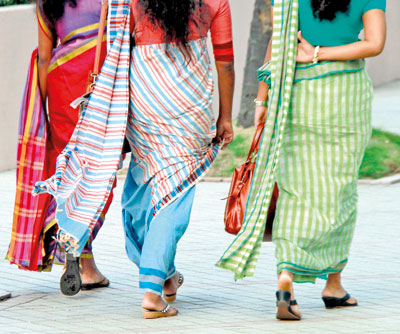A heart-to-heart; woman-to-woman plea
It was straight from the heart of one woman to another and also to health authorities not only in Sri Lanka but the whole of Asia.
“We need to educate the Asian woman, give her access and time for risk factor control, advise her to get into simple practical clothing and stress to her the need for both herself and her family to have healthy food habits, with meals including lots of vegetables and fruits and less salt and sugar,” said Consultant Cardiologist Dr. Jayanthimala Jayawardena who was formerly attached to the National Hospital of Sri Lanka (NHSL).

Our taditional attire restricts taking a brisk walk as a form of exercise amidst a busy schedule. Pix by Indika Handuwala
Dr. Jayawardena’s passionate plea targeted a distinguished gathering of heart doctors when she addressed them recently as Zonal Vice President (Zone 3) of the Asia Pacific Society of Cardiology at its Biennial Congress in Singapore. Strongly urging that mothers should encourage their children, both boys and girls, to play outdoors to get enough exercise, she proposed that the genetic basis for the high prevalence of Cardio-Vascular Disease (CVD), Polycystic Ovarian Syndrome (PCOS) and Rheumatic Heart Disease (RHD) in Asian women should be thoroughly explored.
She showed the important and multiple roles that the Asian woman plays in the household and the workplace and society’s expectations of her, sometimes allowing only limited mobility with certain restrictions in what clothes she can wear. But some plus points are that her tobacco use is low, she is responsible for food procurement and preparation and also overseeing the welfare of her children including their food, education and play times. As such she can inculcate healthy habits in her own daughters, thus breaking the vicious circle that she may be caught in.
“Even the clothes of the Asian woman limit her movements. Her attire restricts her from taking a brisk walk which would be an ideal form of exercise for her amidst her busy schedule,” says this Cardiologist.
Speaking at length on ‘CVD in Asian Women’, Dr. Jayawardena taking both men and women together, explained that:
CVD is the leading cause of deaths worldwide (30%)
It is the leading cause of deaths in Asia
50% of the global CVD deaths occur in Asia
50% of the global population lives in Asia
25% of the global population lives in South Asia
50% of this population lives below the poverty line, with limited access to healthcare
 However, she says there is economic progress in Asia despite poverty, resulting in urbanization. There is also an aging population and a rise in non-communicable diseases. There is a wide income-gap, with the rich leading inactive lives and the poor consuming less vegetables and fruits, having major impacts on their health status.
However, she says there is economic progress in Asia despite poverty, resulting in urbanization. There is also an aging population and a rise in non-communicable diseases. There is a wide income-gap, with the rich leading inactive lives and the poor consuming less vegetables and fruits, having major impacts on their health status.
Taking up the question of why women differ from men in Asia, Dr. Jayawardena was quick to point out many factors:
In-utero (in the womb)à Sex selective abortion
Infancyà Natural neglect with regard to nutrition, immunization and medical care
Childhoodà Poor health/education access
Adolescenceà Lack of education, illiteracy and sexual violence
Adulthoodà Early marriage, diseases of reproduction, restricted freedom, rape and dowry deaths
Old ageà Limited freedom, limited movement and lack of financial resources
Comparing CVD risk factors, she pointed out that Asian women are less physically active than western women and Asian men. Asian women are also more obese than Asian men, while they face higher CVD risks linked to eclampsia when they are pregnant. (If a woman becomes prone to pre-eclampsia which is a condition triggered by pregnancy and is characterized by the onset of high blood pressure and a significant amount of protein in the urine, the life-threatening complication of eclampsia may lead to her developing seizures or getting into a coma.)
In the Asian woman who is going through a pregnancy, heart disease could cause complications, gestational diabetes, pregnancy-induced hypertension, high prevalence of PCOS and a high prevalence of RHD .
According to Dr. Jayawardena simple measures can bring down the risks. One measure within their grasp is weight loss in obese women which will lead to a decrease in blood sugar and fasting insulin, a decrease in inflammatory markers to non-obese levels and an improvement in endothelial (the endothelium is the cells that line the interior surface of blood vessels and lymphatic vessels) function.
A strong plea goes out from this Cardiologist on how to keep the Asian woman’s heart healthy — health education, time and access for risk factor control and practical, simple clothing.


